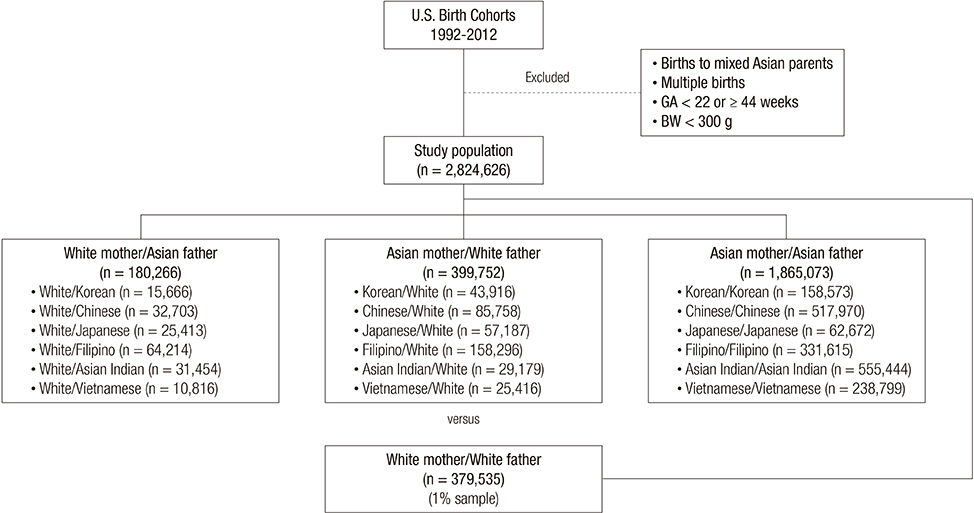J Korean Med Sci.
2016 Dec;31(12):1949-1956. 10.3346/jkms.2016.31.12.1949.
Births to Parents with Asian Origins in the United States, 1992–2012
- Affiliations
-
- 1Department of Pediatrics, Dongguk University Ilsan Hospital, Goyang, Korea.
- 2Department of Pediatrics, CHA Gangnam Medical Center, CHA University, Seoul, Korea. g-daughter@hanmail.net
- 3Department of Pediatrics, University of Chicago Comer Children’s Hospital, Chicago, CA, USA.
- KMID: 2355624
- DOI: http://doi.org/10.3346/jkms.2016.31.12.1949
Abstract
- Despite a remarkable increase in Asian births in the U.S., studies on their birth outcomes have been lacking. We investigated outcomes of births to Asian parents and biracial Asian/White parents in the U.S. From the U.S. birth data (1992-2012), we selected singleton births to Korean, Chinese, Japanese, Filipino, Asian Indian, and Vietnamese. These births were divided into three groups; births to White mother/Asian father, Asian mother/White father, and births to the both ethnic Asian parents. We compared birth outcomes of these 18 subgroups to those of the White mother/White father group. Mean birthweights of births to the Asian parents were significantly lower, ranging 18 g to 295 g less than to the White parents. Compared to the rates of low birthweight (LBW) (4.6%) and preterm birth (PTB) (8.5%) in births to the White parents, births to Filipino parents had the highest rates of LBW (8.0%) and PTB (11.3%), respectively, and births to Korean parents had the lowest rates of both LBW (3.7%) and PTB (5.5%). This pattern of outcomes had changed little with adjustments of maternal sociodemographic and health factors. This observation was similarly noted also in births to the biracial parents, but the impact of paternal or maternal race on birth outcome was different by race/ethnicity. Compared to births to White parents, birth outcomes from the Asian parents or biracial Asian/White parents differed depending on the ethnic origin of Asian parents. The race/ethnicity was the strongest factor for this difference while other parental characteristics hardly explained this difference.
Keyword
MeSH Terms
Figure
Reference
-
1. United States Census Bureau. The Asian population: 2010. 2010 census briefs [Internet]. accessed on 15 March 2015. Available at http://www.census.gov/prod/cen2010/briefs/c2010br-11.pdf.2. Singh GK, Yu SM. Pregnancy outcomes among Asian Americans. Asian Am Pac Isl J Health. 1993; 1:63–78.3. Singh GK, Yu SM. Birthweight differentials among Asian Americans. Am J Public Health. 1994; 84:1444–1449.4. Le LT, Kiely JL, Schoendorf KC. Birthweight outcomes among Asian American and Pacific Islander subgroups in the United States. Int J Epidemiol. 1996; 25:973–979.5. Fuentes-Afflick E, Hessol NA. Impact of Asian ethnicity and national origin on infant birth weight. Am J Epidemiol. 1997; 145:148–155.6. Madan A, Holland S, Humbert JE, Benitz WE. Racial differences in birth weight of term infants in a northern California population. J Perinatol. 2002; 22:230–235.7. Qin C, Gould JB. The Asian birth outcome gap. Paediatr Perinat Epidemiol. 2006; 20:279–289.8. Rao AK, Cheng YW, Caughey AB. Perinatal complications among different Asian-American subgroups. Am J Obstet Gynecol. 2006; 194:e39–41.9. Rao AK, Daniels K, El-Sayed YY, Moshesh MK, Caughey AB. Perinatal outcomes among Asian American and Pacific Islander women. Am J Obstet Gynecol. 2006; 195:834–838.10. Wong LF, Caughey AB, Nakagawa S, Kaimal AJ, Tran SH, Cheng YW. Perinatal outcomes among different Asian-American subgroups. Am J Obstet Gynecol. 2008; 199:382.e1–382.e6.11. Nystrom MJ, Caughey AB, Lyell DJ, Druzin ML, El-Sayed YY. Perinatal outcomes among Asian-white interracial couples. Am J Obstet Gynecol. 2008; 199:385.e1–385.e5.12. Schempf AH, Mendola P, Hamilton BE, Hayes DK, Makuc DM. Perinatal outcomes for Asian, Native Hawaiian, and other Pacific Islander mothers of single and multiple race/ethnicity: California and Hawaii, 2003–2005. Am J Public Health. 2010; 100:877–887.13. Institute of Medicine Committee to Study the Prevention of Low Birthweight (US). Preventing Low Birthweight. Washington, D.C.: National Academy Press;1985.14. U.S. Department of Health and Human Services, Health Resources and Services Administration. Child health USA 2011 [Internet]. accessed on 15 March 2016. Available at http://mchb.hrsa.gov/chusa11/more/downloads/pdf/c11.pdf.15. Acevedo-Garcia D, Soobader MJ, Berkman LF. The differential effect of foreign-born status on low birth weight by race/ethnicity and education. Pediatrics. 2005; 115:e20–30.16. Morrow HW, Chávez GF, Giannoni PP, Shah RS. Infant mortality and related risk factors among Asian Americans. Am J Public Health. 1994; 84:1497–1500.17. Gould JB, Madan A, Qin C, Chavez G. Perinatal outcomes in two dissimilar immigrant populations in the United States: a dual epidemiologic paradox. Pediatrics. 2003; 111:e676–82.18. Baker LC, Afendulis CC, Chandra A, McConville S, Phibbs CS, Fuentes-Afflick E. Differences in neonatal mortality among whites and Asian American subgroups: evidence from California. Arch Pediatr Adolesc Med. 2007; 161:69–76.19. Pew Research Center (US). Multiracial in America: proud, diverse and growing in numbers [Internet]. accessed on 15 March 2016. Available at http://www.pewsocialtrends.org/2015/06/11/multiracial-in-america/.20. Lim JW, Lee JJ, Park CG, Sriram S, Lee KS. Birth outcomes of Koreans by birthplace of infants and their mothers, the United States versus Korea, 1995-2004. J Korean Med Sci. 2010; 25:1343–1351.
- Full Text Links
- Actions
-
Cited
- CITED
-
- Close
- Share
- Similar articles
-
- Comparison of Neonatal and Infant Mortality Rates between Infants Born in South Korea and Those Born in the United States
- Birth Outcomes of Koreans by Birthplace of Infants and Their Mothers, the United States versus Korea, 1995-2004
- A Comprehensive Assessment of the Racial and Ethnic Disparities in the Incidence of Gastric Cancer in the United States, 1992-2014
- Historical Development of Forensic Pathology in the United States
- Response: Smartphone Applications Providing Information about Stroke: Are We Missing Stroke Risk Computation Preventive Applications?


